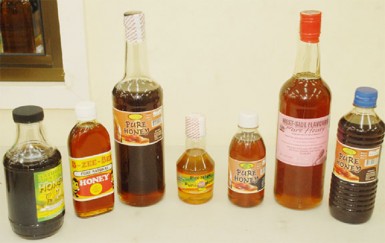If you happen by the Guyana Marketing Corporation’s Guyana Shop on any trading day you will almost certainly be struck by the number of products on display on the shelves. The bottling and labelling too are a considerable improvement on the standards of earlier years; the manufacturers not only having come to terms with the nexus between presentation and competitiveness but also having committed themselves to investing more meaningfully in marketing their products.
The Guyana Shop does not attract the numbers of customers who find their way into regular supermarkets because it offers a limited range of products, mostly locally manufactured food products made by various small businesses from across the country. That is the Ministry of Agriculture’s way of providing marketing support for the efforts of local agro-processors.
A few weeks ago, a group of holidaying Guyanese were in the Guyana Shop, examining the various brands of seasonings and checking on prices. As far as such condiments are concerned they are spoilt for choice and while the number of brands point to a decade and more of energetic pursuit of commercial agro-processing, the proliferation of several different brands of the same product gives rise to its own problems.

Claudia Reece, an East Coast market vendor, has put on hold, a pepper sauce venture which she has been contemplating for almost a year. She made the decision to pull out of it in February after discovering that the various shops, supermarkets and vending stands across the country offer at least half a dozen brands of pepper sauce to say nothing of the unbranded range displayed on small stalls in municipal markets. Add the imported hot sauces and it becomes clear that Guyana’s limited market creates an unbearable level of competition.
At the Guyana Shop, the situation was much the same with seasoning, food sauces and casareep – several brands of the same product. What was clear, too, was that customer preferences were leaving some brands behind.
General Manager of the Guyana Shop Kevin Macklingham is intimate with the problem. When the issue was raised with him, he conceded that it was “a valid point.”
Macklingham said much of his time is spent engaging visitors to the shop seeking space for a familiar product on its shelves. “Whenever they come with such a product, I take them to the shelves and point out to them the number of brands of the same product that we already have. Sometimes there are conversations about possible alternative products but at the end of the day they want their product on the shelves and that is what we are here to do,” Macklinghham said.
It makes the Guyana Shop an unusual sort of trading space, driven solely by an official policy that seeks to go as far as it can in supporting the marketing of locally manufactured products. In the case of items of food, producers are entitled to space on the shelves once they satisfy the national food safety regulations. In fact, Macklingham said that the situation would probably be far more challenging but for the food safety barrier that keeps some products off the Guyana Shop’s shelves.
The surfeit of multiple brands of the same product appears to have arisen out of the overwhelming popularity of particular types of condiments and seasonings. Pepper comes readily to mind, as do green seasonings. Few of the consumers with whom this newspaper spoke had not tried their own kitchen varieties of pepper sauces and green seasonings. Indeed, several of them said that they never buy those products off the supermarket shelves.
Reece told Stabroek Business that she had been taught a special recipe for pepper sauce by her mother. She said that more women are attending mostly informal classes, learning how to make food seasonings but that what was being taught was limited in range. “We don’t use the full range of fruits that we have. I don’t think we have a single popular local mango chutney, but we just cut up mango and sell it. I don’t think we do anything with plums. We could also do a lot more with guava,” she said.
There are, it seems, limits to the spirit of enterprise with which the agro processing industry is seized. It goes beyond that, however. Small agro-processing ventures that operate on shoestring budgets lack the capital to invest in the kinds of trial and error pursuits that so often yield new products. More than that, low budget enterprises do not have at their disposal the technology which, so often, make a difference in the manufacturing process.
Limited domestic markets mean that much of our agro processed foods must seek external markets. Here again there are challenges. There is still a considerable gap between the standards required to meet local food safety requirements and those that apply in the face of the imposing food safety barriers that keep much of our goods out of North American markets, so that the challenge here is twofold. First, small agro processors must seek to raise their production standards to meet the health and safety requirements of external markets. At the same time there is need for aggressive product diversification that will offer greater variety and a broader range of choices to consumers. Otherwise the competition will simply drive many producers out of business.





